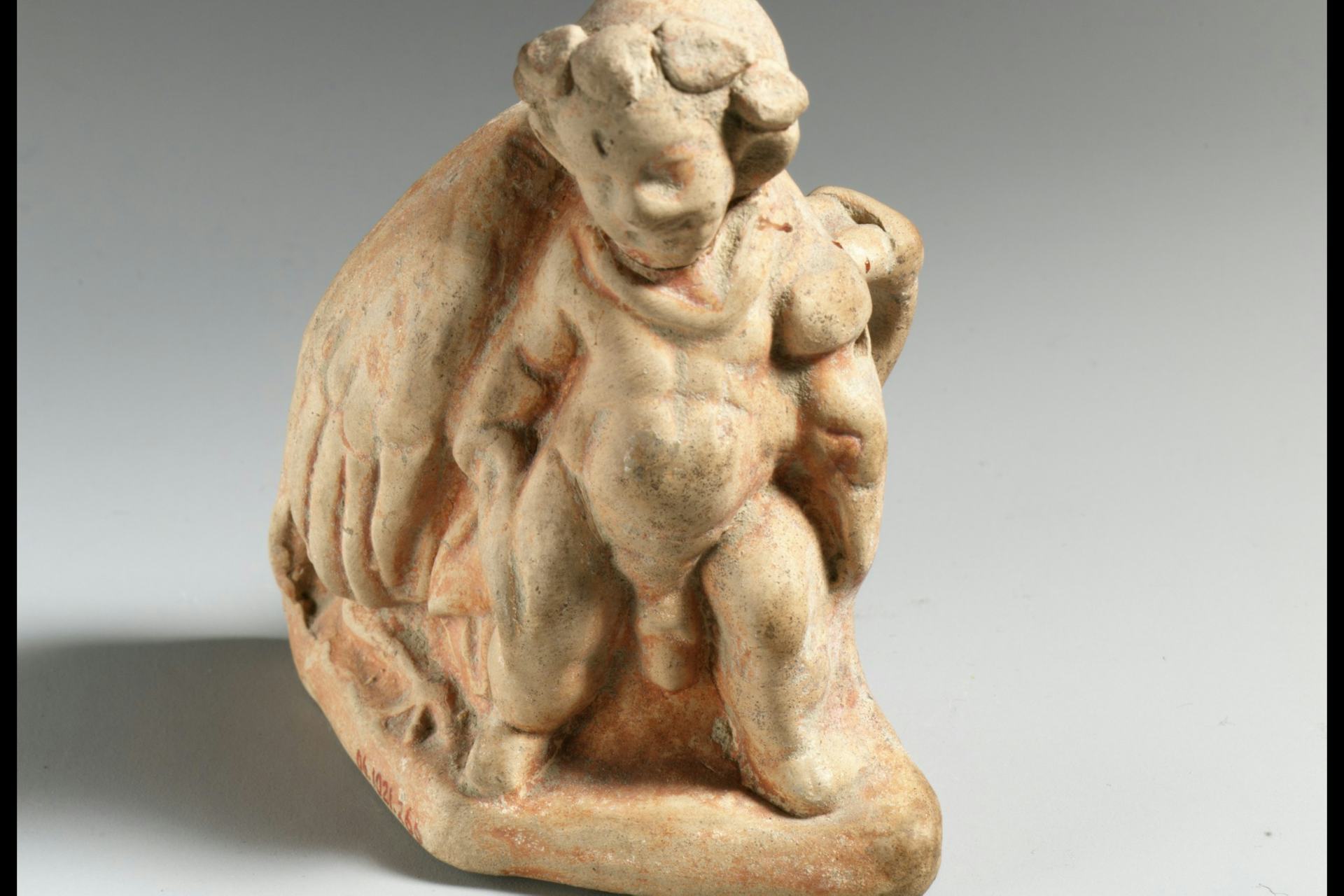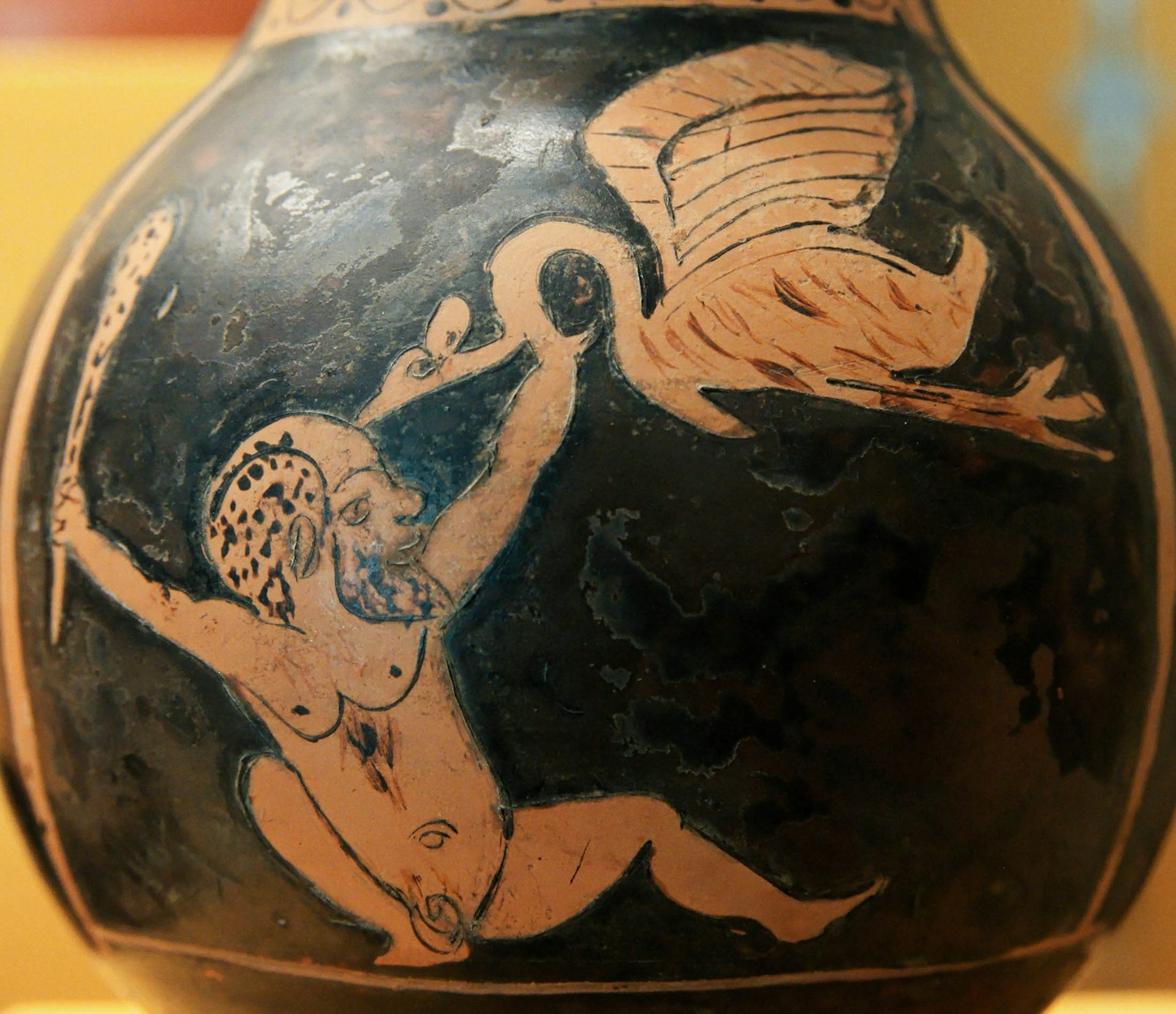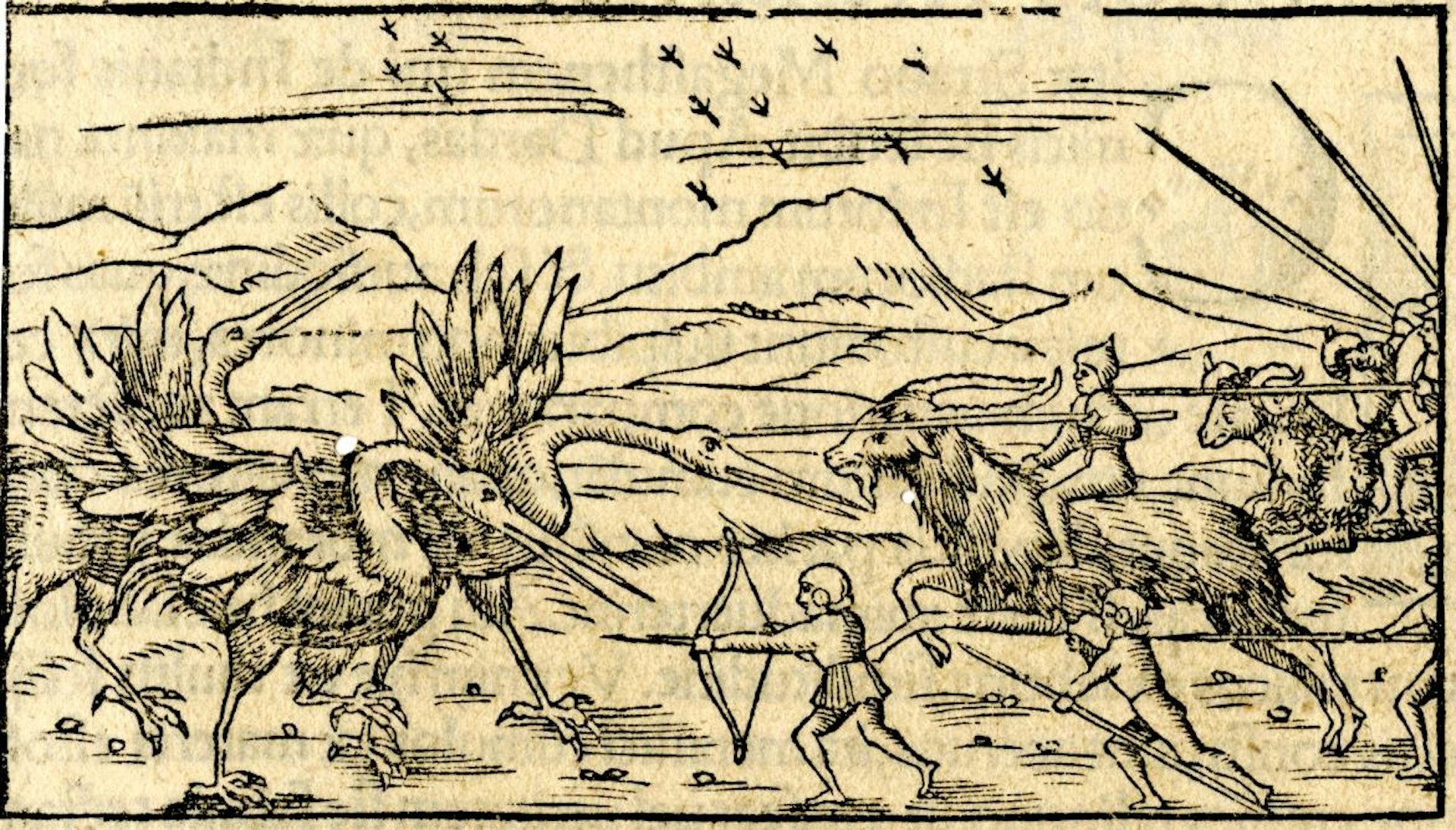Pygmies

Terracotta vase in the form of a pygmy carrying a dead crane (third century BCE)
The Metropolitan Museum of ArtPublic DomainOverview
The Pygmies, sometimes called the offspring of Poseidon and Gaia, were a race of dwarf-like creatures, notable for their astonishingly small size. They were said to live at the edge of the world—possibly in Africa, India, or even the far north. The Pygmies were most often associated with the Geranomachy, their ongoing conflict with the cranes; the birds would swoop down on Pygmy communities, bringing death and destruction in their wake.
The myth of the Pygmies and the Geranomachy was highly popular in antiquity. It can be found in texts as early as the Homeric epics (eighth century BCE) and remained familiar in subsequent ancient literature and art. The Pygmies, forever embroiled in their war with the cranes, were frequently used as a kind of comic relief.
Etymology
The Pygmies (Greek Πυγμαῖοι, translit. Pygmaîoi) got their name from the Greek word πυγμή (pygmḗ), meaning “fist.” The term “Pygmies” can thus be translated as “fist-sized,” a reference to their extremely small stature.
Pronunciation
English
Greek
Pygmies Πυγμαῖοι (Pygmaîoi) Phonetic
IPA
[PIG-meez] /ˈpɪg miz/
Attributes
Locales
The tiny Pygmies were typically thought to live at the edge of the world. The exact location of their home, however, varied depending on the source. Homer placed the Pygmies, rather vaguely, on the distant banks of the world-encircling Oceanus.[1] But other authorities located the Pygmies either in Africa[2] to the south; Caria[3] or India[4] to the east; or in Thrace,[5] Colchis,[6] or even the legendary land of Thule[7] to the north.
Appearance and Abilities
The Pygmies were defined by their remarkably small stature. Indeed, the name “Pygmy,” derived from the Greek word for “fist,” is probably a reference to their height (at the time, “fist” indicated the distance from the knuckles to the elbow—approximately 34 cm). In antiquity, the word “Pygmy” could actually be used as a general term for any short person.[8]
Detailed descriptions of the Pygmies’ physical appearance are rare in ancient literature. However, one vivid portrait of these strange beings can be found in the fragments of Ctesias’ writings. According to Ctesias, the Pygmies were bearded and deformed, with oversized genitalia, and generally only reached a height of around one and a half cubits (or approximately 79 cm).[9]
The Pygmies lived in rough shelters, making their homes either in caves,[10] underground,[11] or in houses made of mud mixed with bird feathers and eggshells.[12] They were usually envisioned as farmers of some kind; the early historian Hecataeus, for example, described them growing wheat, which they reaped with axes.[13] According to Ctesias and others, their domestic animals were of a dwarf breed, matching their own physiognomy.[14]
War was also an important aspect of the Pygmies’ existence—especially their ongoing war with the cranes. It was said that the Pygmies rode into battle atop goats, rams, or partridges, wielding bows and arrows or clanging castanets.[15]
Iconography
Pygmies were a popular subject in ancient art beginning in the early sixth century BCE (if not earlier). They first appeared in Greek art and were later adopted by the Etruscans and Romans.
Pygmies were generally represented in Geranomachy scenes—that is, in battle against the cranes (though it was not unknown for artists to show them fighting other animals as well, such as chickens, geese, frogs, or pigs). Such scenes can be found in vase paintings, mosaics, wall paintings, and on engraved gems.
The Pygmies were often shown armed and riding into battle on the backs of wild animals. In the earliest depictions, they looked more or less like miniature humans; but over time, their appearance became more and more grotesque, with artists giving them large heads, short limbs, and oversized genitalia.[16]

Attic red-figure oenochoe (ca. 430–420 BCE) showing a Pygmy fighting a crane
National Archaeological Museum, Madrid / Marie-Lan NguyenCC BY 2.5Family
Origins
The origins of the Pygmies are hazy. It is possible that the myth emerged from actual encounters between the ancient Greeks and communities of particularly short humans, such as those of central Africa. Greek historians like Herodotus did meet and write about such people (even if they did not explicitly refer to them as “Pygmies”).[20] Europeans would later name the so-called “African Pygmies” after the memorable creatures of Greek mythology.
However, it is also possible that the mythical Pygmies had no basis in reality and were instead merely a product of the Greeks’ love of all things fantastical and fabulous. Indeed, ancient authors did not usually refer to actual populations of short humans as “Pygmies,” reserving the term for a remote race of beings known only from myth.
The Geranomachy
The Pygmies were associated first and foremost with the Geranomachy, their eternal war against the cranes. Homer’s Iliad, the earliest surviving work of Greek literature, mentions how
the clamour of cranes ariseth before the face of heaven, when they flee from wintry storms and measureless rain, and with clamour fly toward the streams of Ocean, bearing slaughter and death to Pigmy men, and in the early dawn they offer evil battle.[21]
The cranes, it seems, were thought to regularly attack the fields of the Pygmies, bringing destruction and death in their wake. It was said that these attacks occurred each autumn, when migrating cranes would swoop down on the Pygmies’ crops and massacre any Pygmies they came upon.[22] The Pygmies would in turn arm themselves and ride into battle to drive the cranes away. According to some accounts, the Pygmies would also organize retaliatory expeditions, destroying the cranes’ nests and any eggs or chicks they found inside.[23]

Woodcut showing the battle of the Pygmies and the cranes. From Sebastian Münster, Cosmographia (ca. 1544–1552).
British Museum, LondonCC BY-NC-SA 4.0One tradition sought to explain how this terrible war between the Pygmies and cranes began. As the story goes, there was an unusually beautiful Pygmy named Oenoe (other sources call her Gerana); the Pygmies lavished numerous honors on her and eventually made her their queen. But Oenoe became proud and scorned the gods, especially Hera. As punishment, Hera transformed Oenoe into a hideous bird—a crane.
Though banished from her old Pygmy community, Oenoe longed to see her son, an infant named Mopsus whom she had had with her Pygmy husband Nicodamas. But every time she tried to visit Mopsus, the Pygmies would chase her away. Oenoe took to attacking the Pygmies, eventually leading her own army of cranes. These hostilities, it was said, evolved into the Geranomachy.[24]
The Pygmies Meet Heracles
There was at least one further myth about the Pygmies that had nothing to do with their war against the cranes. According to this tradition, the Pygmies had a brother, Antaeus, who was as large as they were small. Antaeus lived in Libya, where he wrestled all those who visited his land. Because he was a child of Gaia, the goddess of the earth, Antaeus was invincible as long as he was touching the ground and would always defeat his opponents. But this came to an end when he met Heracles, who bested him by hoisting him off the ground and crushing him to death.
According to one obscure story, the Pygmies tried to avenge their brother’s untimely demise. When Heracles laid down to sleep, they organized into cohorts, each one assigned a different part of the hero’s massive body, and attacked. But Heracles woke up and easily defeated the miniscule foes. He then wrapped them in his lion skin and took them to Eurystheus, the king of Mycenae, who had assigned Heracles his famous Twelve Labors.[25]
Pop Culture
The Pygmies of Greek mythology retained their notoriety in Western literature for many centuries, appearing in works such as Nathaniel Hawthorne’s Tanglewood Tales. Today, however, “Pygmy” is mostly encountered as a rather outdated term for ethnic groups of unusually short humans. The name is most often associated with the “African Pygmies” of central Africa, such as the Bambenga and Bayaka peoples, though there are also “Pygmy” populations in Asia and Oceania.